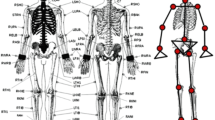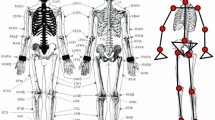Abstract
A mathematical model for the analysis of human motion is presented in this paper. This model is based on linkage dynamics in order to understand trajectory and internal moment of force coordination. Mobility at the base of the supporting limb is a critical factor in the freedom to fall forward. The approach used to state a coupled system of differential equations of motion consists in introducing the displacement of the center of mass together with the displacement of each segment of the body and to evaluate the final system as a whole. The resultant methodology is task independent. The main goal of this study is to assist the work of health care professionals in the determination of the torques at the joints generated to maintain the movement. The evaluation of a weighted average of all the forces has served as a basis for other authors to obtain the center of pressure. In this work, the resultant ground reaction force passes through the center of mass of the body system enabling the calculation of the location of this force.
Similar content being viewed by others
References
Pandy, M.G.: Computer modeling and simulation of human movement. Ann. Rev. Biomed. Eng. 3, 245–273 (2001)
Bresler, B., Frankel, J.P.: The forces and moments in the leg during level walking. Trans. ASME 72, 27–36 (1950)
Wells, R.P.: The projection of the ground reaction force as a predictor of internal joint moments. Bull. Prosthet. Res. 18(1), 15–19 (1981)
Yamaguchi, G.T., Zajac, F.E.: Restoring unassisted natural gait to paraplegics via functional neuromuscular stimulation: a computer simulation study. IEEE Trans. Biomed. Eng. 37,886–902 (1990)
Silva, M.P.T., Ambrósio, J.A.C.: Kinematic data consistency in the inverse dynamic analysis of biomechanical systems. Multibody Syst. Dyn. 8, 219–239 (2002)
Silva, M.P.T., Ambrósio, J.A.C.: Sensitivity of the results produced by the inverse dynamic analysis of a human stride to perturbed input data. Gait Posture 19, 35–49 (2004)
Pandy, M.G., Zajac, F.E., Sim, E., Levine, W.S.: An optimal control model for maximum-height human jumping. J. Biomech. 23(12), 1185–1198 (1990)
Liu, W., Nigg, B.M.: A mechanical model to determine the influence of masses and mass distribution on the impact force during running. J Biomech. 33, 219–224 (2000)
Zajac, F.E., Gordon, M.E.: Determining muscle's force and action in multi-articular movement. Exercise Sport Sci. Rev. 17, 187–230 (1989)
Perry, J.: Gait Analysis: Normal and Pathological Function. SLACK, Thorofare, NJ (1992)
Winter, D.A.: Biomechanics and Motor Control of Human Movement. 2nd edn. Wiley, New York (1990)
Cappozzo, A., Croce, U.D., Leardini, A., Chiari, L.: Human movement analysis using stereophotogrammetry — Part 1: theoretical background. Gait Posture 21, 186–196 (2004)
Dahlkvist, N.J., Mayo, P., Seedhom, B.B.: Forces during squatting and rising from a deep squat. Eng. Med. 11, 69–76 (1982)
Silva, M.P.T., Ambrósio, J.A.C.: Consequences of using kinematic interpolated data for the solution of the redundant problem in biomechanics. In: Rodrigues, H. et al. (ed.) Proceedings of the Second International Conference on Computational Bioengineering, pp. 965–976. IST, Lisbon, Portugal (2005)
Bartlett, R.: Sports Biomechanics. Reducing Injury and Improving Performance. Spon, New York (1991)
Fish, D., Nielsen, J.: Clinical assessment of humain gait. Prosthet. Orthot. J. 5, 39–48 (1993)
Saunders, J.B. de C.M., Inman, V.T., Eberhart, H.D.: The major determinants in normal and pathological gait. J. Bone Joint Surg. 35-A(3), 543–558 (1953)
Author information
Authors and Affiliations
Corresponding author
Rights and permissions
About this article
Cite this article
Consiglieri, L., Pires, E.B. Analytical approach for the evaluation of the torques using inverse multibody dynamics. Multibody Syst Dyn 18, 471–483 (2007). https://doi.org/10.1007/s11044-007-9046-6
Received:
Accepted:
Published:
Issue Date:
DOI: https://doi.org/10.1007/s11044-007-9046-6




